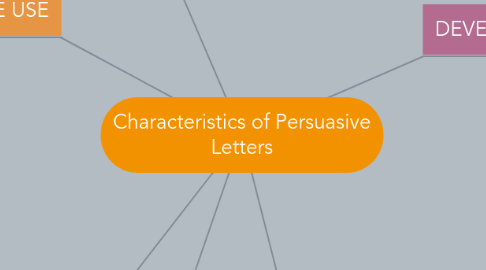
1. TEXT LAYOUT
1.1. Letter Format
1.1.1. Organized into paragraphs (Intro, body, conclusion)
1.1.1.1. Indent or in blocks
1.1.2. Structure
1.1.2.1. Include date
1.1.2.2. Closing depends on audience
1.1.2.2.1. "Sincerely"
1.1.2.3. Type your name 3 lines after closing
1.1.2.3.1. Sign in pen in cursive
1.1.2.4. Include return address (your name & where it's coming from)
1.1.2.5. Opening "Dear...."
1.1.3. Envelopes
1.1.3.1. Needs a stamp
1.1.3.2. include who/where it's going & who/where it's coming from
1.1.4. Neatly folded into thirds
2. LANGUAGE USE
2.1. Directly address audience ("you")
2.2. 1st person ("I")/2nd person ("you")/3rd person ("he/she/they")
2.3. Ask questions to make them think about what you're saying
2.4. Makes a "play on words" (pun)
2.5. Uses simile to make a point
2.6. Creates a picture in the reader's mind
2.7. Ask & answer questions throughout your piece
2.8. Descriptive
3. VOICE
3.1. Show that you are serious
3.1.1. proper grammar, traditional format
3.2. Sound confident in what you believe
3.2.1. Very convincing
3.3. Interacts with audience
3.4. Sounds like you know what you're talking about
3.5. Evoke an emotion in the reader
3.5.1. Make them bad/guilty
3.6. Respectful tone
3.6.1. Assertive
3.7. Style depends on audience
3.8. Interacts with audience
3.9. Include opinion
4. WORD CHOICE
4.1. Keep it interesting
4.1.1. Descriptive words
4.2. Powerful words
4.3. Interesting/unusual words
4.3.1. Words are not "normal"
4.4. Use language that's appropriate for audience
4.5. Very descriptive words
4.6. Vocabulary/word choice sounds like you know what you're talking about
5. DEVELOPING IDEAS
5.1. added a lot of supporting details
5.2. Describe how it affects the audience
5.3. Include statistics (surprising or shocking)
5.3.1. Percentages
5.4. Requires a lot of research
5.5. Lots of reasons why
5.6. Include facts/statistics
5.7. Choose facts that support your argument
5.8. Gave specific examples
5.8.1. based on eyewitness
5.9. Having a lot of facts to back up opinion
5.10. Focused & on topic (Getting message across)
5.10.1. Stay on topic
5.11. Explain why the "way things are" is bad
5.11.1. Identifying the problem (what they're doing wrong)
5.12. Explains causes & effects
5.13. Make your audience feel bad
5.14. Clear & makes sense
5.14.1. Rereading several time (ask someone else to reread)
5.15. Tell them what other people are doing help
5.15.1. Tell the audience what he/she/they can do
5.16. Goal: To get someone to do something
5.17. Gives examples
5.18. Firsthand experience
5.19. Uses information to back up ideas
5.20. Very specific examples
5.21. Might connect to a life event
5.22. Compare & contrast different ideas
5.23. Makes reader want to take action
5.24. Gives history, connects to tradition
5.25. If you have to include negative information, counteract it
5.26. Include "depressing" information
5.27. Explain how audience can benefit
5.27.1. voice depends on audience
5.27.2. might challenge the reader
5.28. Include background information
5.28.1. what made you want to write
5.29. Acknowledge the other side
5.29.1. "counterargument"
5.30. Choose the good facts (ones that will support your argument)
5.31. Back up with reasons why
5.31.1. need evidence
5.32. Use facts/statistics to back up your argument
5.32.1. Research background information
5.33. Use compliments/"buttering up"
5.34. Include evidence based on something you've seen
5.35. Purpose: To get someone to do something
5.35.1. or not to do something
5.36. Include what would happen if someone does or does not do what you are suggesting
5.37. Include statistics
5.38. Get to point quickly
6. ORGANIZATION
6.1. Get to the point quickly
6.2. 5 Paragraphs
6.2.1. Intro paragraph
6.2.2. 3 reason paragraphs
6.2.3. Concluding pargraph
6.3. Closing wraps everything up
6.3.1. "Call to action"
6.4. Start with some kind of hook/grabber
6.4.1. Question
